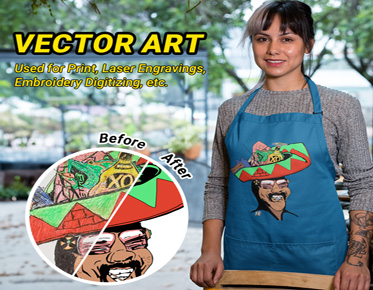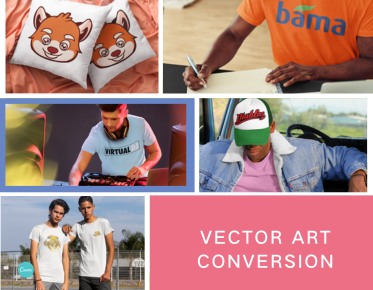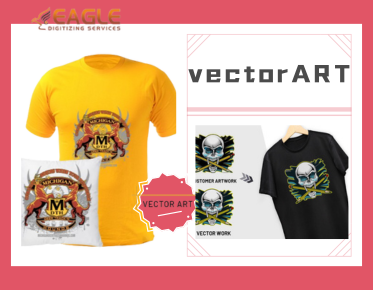Rethinking Art: Sustainability in the Creation of Vector Art
In an age where environmental concerns are paramount, the intersection of art and sustainability has become a vital discussion. Vector art, a form of digital creativity characterized by its scalability and precision, presents unique challenges and opportunities in this realm. As artists embrace the digital canvas, they must also consider the ecological footprint of their work. Can vector art exist harmoniously with sustainability? This exploration delves into the various dimensions of sustainable practices within the creation of vector art, examining the environmental impact, promoting eco-conscious design principles, and highlighting the artist's role in fostering a greener future. Read Here are Some Vital Elements That You Should Comprehend About custom vectorization services.
The Environmental Impact of Digital Art
The Carbon Footprint of Digital Creation
While digital art might seem inherently more sustainable than traditional mediums—after all, there are no paint, canvas, or physical materials involved—the reality is more nuanced. The carbon footprint of digital creation can be significant. From the electricity-powering computers to the data centers that host online portfolios, each click and brush stroke has a hidden cost. As the demand for digital art increases, so does the energy consumption associated with its creation, leading to a paradox where art intended to inspire can also contribute to environmental degradation.
Energy Consumption: The Hidden Costs of Technology
Technology, while enabling artists to create with unprecedented freedom, also comes with hidden costs. High-performance computers and tablets consume vast amounts of energy, especially when used for intensive tasks like rendering complex vector graphics. Even software applications require significant power to run efficiently. The cumulative energy consumption can lead to an alarming increase in greenhouse gas emissions, urging artists to reconsider their reliance on high-energy devices and seek alternatives that mitigate their impact on the planet.
E-Waste: The Environmental Challenge of Digital Tools
E-waste presents another challenge in the realm of digital art. As technology advances, devices become obsolete at an astonishing rate. Artists often find themselves discarding old computers and tablets, contributing to the growing problem of electronic waste. This waste, laden with harmful materials, poses significant environmental hazards when not disposed of properly. By understanding the lifecycle of their tools, artists can make informed decisions that minimize e-waste and promote sustainable practices.
Sustainable Practices in Digital Art Creation
Choosing Eco-Friendly Software and Tools
The software and tools artists choose can greatly influence their environmental impact. Opting for eco-friendly applications that prioritize energy efficiency and lower carbon footprints is a step towards sustainability. Some platforms even offer features designed to minimize resource consumption, helping artists reduce their overall environmental impact while still delivering high-quality work. By consciously selecting tools that align with their values, artists can create art that not only reflects their creativity but also their commitment to the planet.
The Role of Cloud Computing in Reducing Carbon Footprint
Cloud computing has emerged as a promising solution for reducing the carbon footprint associated with digital art creation. By utilizing cloud services, artists can access powerful computing resources without the need for high-performance hardware at home. This shift can significantly lower individual energy consumption, as cloud providers often employ energy-efficient data centers optimized for sustainability. Embracing cloud technology not only enhances collaboration but also fosters a greener approach to digital artistry.
Using Sustainable Hardware: Making Smart Choices
Investing in sustainable hardware is crucial for artists aiming to lessen their environmental impact. Energy-efficient devices, such as those certified by ENERGY STAR, consume less power while maintaining performance, making them an excellent choice for creatives. Furthermore, choosing products from companies that prioritize sustainability in their manufacturing processes can amplify the positive effects. By making smart hardware choices, artists can significantly reduce their energy consumption and support brands committed to eco-friendly practices.
Materials Matter: The Tools of the Trade
Selecting Energy-Efficient Devices for Creation
Selecting energy-efficient devices goes beyond simply picking the latest model. It requires artists to research and evaluate the energy consumption ratings of their tools. For instance, laptops and monitors with low energy requirements can make a substantial difference in reducing overall electricity use. By prioritizing devices designed for efficiency, artists can enjoy enhanced performance while contributing to a more sustainable creative process.
The Importance of Responsible Disposal of Old Equipment
As technology evolves, the need for responsible disposal of old equipment becomes paramount. E-waste recycling programs provide a sustainable solution, ensuring that electronic devices are disposed of properly and that harmful materials do not enter landfills. Artists can take proactive steps by participating in local e-waste recycling initiatives or donating functional equipment to educational institutions. This responsible approach not only reduces waste but also supports the community, allowing others to benefit from their tools.
Exploring Open-Source Software for a Greener Approach
Open-source software offers a refreshing alternative for artists seeking sustainable solutions. Many open-source applications are lightweight and designed for efficiency, consuming less energy compared to their proprietary counterparts. Additionally, these programs foster a spirit of collaboration and sharing, aligning with the ethos of sustainability. By utilizing open-source tools, artists can contribute to a community-driven approach that values innovation without compromising the planet.
Eco-Conscious Design Principles
Minimalism: Less is More in Vector Art
Minimalism has emerged as a powerful design principle, especially within vector art. Emphasizing simplicity and functionality, minimalist designs often utilize fewer elements and colors, inherently reducing the resources required for creation. By embracing minimalism, artists can create visually striking works that resonate with audiences while minimizing their environmental impact. This approach champions the idea that less is indeed more, highlighting the beauty of simplicity in a world often cluttered with excess.
Choosing Sustainable Themes and Subjects
The themes and subjects chosen by artists can significantly influence the message their work conveys. By selecting sustainable themes—such as nature, conservation, and social responsibility—artists can inspire dialogue and raise awareness about critical environmental issues. Vector art that emphasizes eco-conscious themes encourages viewers to reflect on their relationship with the planet, promoting a culture of sustainability through creative expression.
The Power of Green Imagery: Nature-Inspired Art
Nature-inspired art holds immense potential for promoting sustainability. By drawing inspiration from the natural world, artists can create compelling visuals that celebrate the beauty of our environment while advocating for its protection. Incorporating elements like flora and fauna not only enhances the aesthetic appeal of vector art but also serves as a reminder of the interconnectedness of life on Earth. Such imagery has the power to inspire a collective commitment to environmental stewardship.
The Role of the Artist in Promoting Sustainability
How Artists Can Advocate for Environmental Awareness
Artists possess a unique platform for advocating environmental awareness. Through their work, they can spark conversations about pressing issues like climate change, pollution, and deforestation. By leveraging their creativity, artists can engage audiences emotionally, prompting them to consider their actions and their impact on the world. This advocacy can take many forms—whether through exhibitions, social media campaigns, or community projects—allowing artists to amplify their message in diverse ways.
Collaborating with Environmental Organizations
Collaborating with environmental organizations provides artists with opportunities to expand their impact. By partnering with nonprofits focused on sustainability, artists can contribute their talents to campaigns and initiatives aimed at preserving the planet. These collaborations not only enhance the visibility of environmental issues but also create powerful synergies between art and activism, fostering a culture of collective responsibility.
Know Some Artists Making a Difference
Numerous artists have made significant contributions to environmental advocacy through their work. Case studies of these creatives reveal how they utilize their art to promote sustainability. From large-scale murals that raise awareness about climate change to installations that inspire community engagement, these artists demonstrate the transformative power of art in addressing environmental challenges. Their commitment serves as an inspiration for others to leverage their talents for the greater good.
The Business Side of Sustainable Vector Art
Marketing Your Eco-Friendly Art
Marketing eco-friendly art requires a thoughtful approach that resonates with conscious consumers. Artists can emphasize the sustainability of their practices, highlighting their use of energy-efficient tools, eco-friendly materials, and themes centered around environmental awareness. By transparently sharing their commitment to sustainability, artists can attract a niche audience that values conscious consumption, forging connections that transcend traditional market dynamics.
Balancing Profitability and Environmental Responsibility
Finding a balance between profitability and environmental responsibility can be a complex endeavor. While many artists strive to create sustainable practices, the pressure to generate income can sometimes lead to compromises. However, by adopting innovative business models—such as selling digital products or offering services that align with sustainability—artists can maintain their financial stability while upholding their ethical values. This balance allows for a sustainable creative practice that benefits both the artist and the planet.
The Rise of Green Certifications for Artists
The rise of green certifications presents an opportunity for artists to validate their commitment to sustainability. By obtaining certifications from recognized organizations, artists can showcase their eco-friendly practices to potential clients and customers. These certifications serve as powerful tools for marketing, differentiating artists in a crowded market while reinforcing their dedication to environmental responsibility.
The Importance of Education and Awareness
Teaching Sustainability in Art Programs
Education plays a pivotal role in promoting sustainability within the art community. Art programs that integrate sustainability into their curricula can equip future artists with the knowledge and tools necessary to make eco-conscious choices. By fostering a culture of sustainability in educational settings, institutions can inspire the next generation of creatives to prioritize environmental responsibility in their artistic practices.
Resources for Artists on Sustainable Practices
Numerous resources are available to support artists in adopting sustainable practices. From online workshops to guides on eco-friendly materials, these resources empower artists to make informed choices. By exploring these materials, artists can discover new techniques, tools, and approaches that align with their values, ultimately enhancing their creative output while minimizing their environmental impact.
Inspiring the Next Generation of Eco-Conscious Creatives
Inspiring the next generation of eco-conscious creatives involves cultivating a culture of awareness and responsibility. By showcasing successful examples of artists who prioritize sustainability, educators can motivate students to integrate eco-friendly practices into their own work. This emphasis on sustainability not only enriches the artistic landscape but also contributes to a broader movement toward environmental stewardship.
Embracing sustainability in vector artwork is not just a trend; it is a necessary evolution in the creative landscape. Encouraging an ongoing dialogue on sustainability fosters collaboration and innovation, paving the way for a more environmentally conscious art community. The path forward lies in making informed choices that balance creativity with ecological responsibility, ensuring that the vibrant world of vector art continues to thrive while honoring the planet we share.



